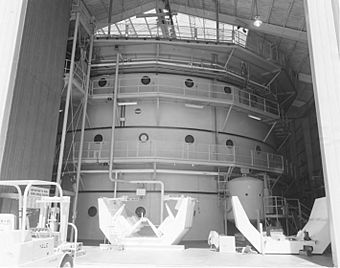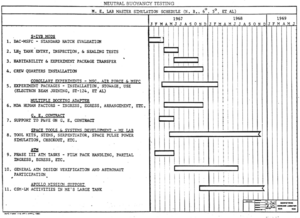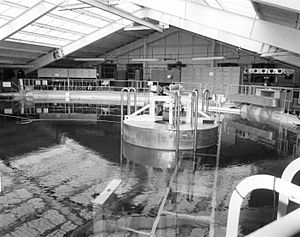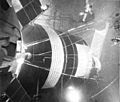Neutral Buoyancy Simulator facts for kids
|
Neutral Buoyancy Simulator
|
|
 |
|
| Location | Huntsville, Alabama |
|---|---|
| Built | 1968 |
| Architect | NASA |
| NRHP reference No. | 85002807 |
Quick facts for kids Significant dates |
|
| Added to NRHP | October 3, 1985 |
| Designated NHL | October 3, 1985 |
The Neutral Buoyancy Simulator was a special pool at NASA's George C. Marshall Space Flight Center (MSFC) in Alabama. From 1968 to 1997, engineers and astronauts used this huge tank. They practiced how to work in space and tested new equipment.
NASA needed a way to train astronauts for spacewalks, also known as extra-vehicular activities (EVAs). They built three increasingly larger tanks for this purpose. The Neutral Buoyancy Simulator was very important for America's space program. It helped with missions like Skylab, the Space Shuttle, the Hubble Space Telescope, and the International Space Station.
Before the mid-1970s, this was the only NASA facility where astronauts could practice moving in a weightless environment. The water in the simulator was kept at a steady temperature. It was also constantly cleaned and filtered. Special systems allowed for underwater sound and video. They also provided air for pressure suits and emergency help. These systems could support up to four suited astronauts at once.
Contents
How the Simulator Works
The simulator uses a trick called neutral buoyancy to make things feel weightless. It's like floating in space! First, large equipment is carefully lowered into the pool using a crane. Then, astronauts put on their space suits and get into the tank. Support divers add special weights to the astronauts. This makes them float perfectly, without sinking or rising. It also stops them from spinning around.
One challenge with using water to simulate space is that water creates drag. This means things move slower in water. To deal with this, astronauts learn to do tasks very slowly. Another thing to remember is that astronauts don't feel weightless inside their suits. So, their suits must fit perfectly for training to be effective.
Early Training Pools
NASA has used special airplanes for many years to create short bursts of weightlessness. In 1959, Project Mercury astronauts trained in a C-131 Samaritan plane. This plane was nicknamed the "Vomit Comet" because of how it made people feel. But these flights only offered about 25 seconds of weightlessness at a time. This wasn't enough to practice spacewalks that could last for hours.
By 1960, NASA started looking into using underwater training. They first tried it in a pool near Langley Research Center. Later, they moved to McDonogh School. Scott Carpenter was the first astronaut to train there in a space suit. After some difficult spacewalks during the Gemini missions, NASA realized how important underwater training was. The Gemini 12 crew even trained at McDonogh.
Meanwhile, at MSFC, engineer Charlie Cooper thought underwater exercises could help plan spacewalks. He and Charles D. Stocks started with a small pool. It was 8 feet (2.4 m) wide and 8 feet (2.4 m) deep. This pool had been used before for shaping metal with explosions. In November 1965, they tested removing parts for a future space station. This was an early step for what would become Skylab.
The Second Training Tank
After seeing how useful the small pool was, workers changed a larger explosive forming tank for training in January 1966. This bigger pool was 25 feet (7.6 m) wide and 15 feet (4.6 m) deep. A large, damaged section from a Saturn V rocket was used to cover the pool. This made it a heated facility with good lighting. It also had more space for bigger equipment.
The budget for this second tank was very tight. They even used a swimming pool filter from a regular store. They also tapped into a nearby steam line to heat the water. It took nearly a year for chemists to find the right balance of chemicals to keep the water clean.
Early tests in this tank also focused on the Skylab workshop. Astronauts practiced getting in and out of an airlock. They also practiced removing a hatch cover.
Astronauts began training in pressure suits in the second tank. The MSFC team developed a special valve. This valve helped maintain neutral buoyancy at any depth. Divers first tried the Navy Mark IV suit in July 1966. On September 6, 1966, Alan Bean spent two hours practicing typical astronaut tasks. Bean was very excited about using neutral buoyancy for Skylab training.
During Bean's dive, his glove leaked, and his suit tore. He had to leave the tank with help from divers. But he continued his exercises in regular scuba gear.

By early 1967, the simulator was fully booked. The main goal was to make sure MSFC-designed equipment was safe and easy to use. Johnson Space Center (then called Manned Spacecraft Center) worked with MSFC. They provided astronauts, medical support, and safety advice for the simulations.
A report from this time noted that people needed both hands for most tasks. One hand did the work, and the other provided leverage. The report also mentioned plans for an even bigger third tank.
Planning for a Bigger Tank
It quickly became clear that a much larger simulator was needed. This was because of the size of Skylab (21.67 feet (6.61 m) wide by 24.3 feet (7.4 m) high) and other future hardware. Building it would require some clever planning and money management. In September 1966, MSFC managers told Wernher von Braun that Houston knew about their plans for a new, large simulator.
There was no budget for new buildings. So, managers decided to build the tank inside an existing building. They used special funds and their own workers. They even found a "leak" under the building. This "leak" required a new, strong concrete foundation. This foundation was prepared in July 1967. It was built to support a tank that would hold 1,300,000 US gallons (4,900,000 L) of water.
The Third and Final Tank
Workers welded the new tank together in October and November 1967. The pool was nearly ready, measuring 40 feet (12 m) deep and 75 feet (23 m) wide. Remaining work included installing a two-ton hoist. They also needed a breathing air system and a recompression chamber. An elevator was planned to move people and equipment.
Final preparations took several more months. Engineers filled the tank slowly. This allowed them to find and fix any leaks along the way. They filled it between February 29 and March 11, 1968. After that, they started installing test equipment. Workers had to invent new ways to put parts together underwater. This was because there wasn't much space between the top of the tank and the building's roof.
With astronauts soon diving in pressure suits, safety became even more important. The Manned Spacecraft Center created a special committee. This committee checked the facility for safety issues. They inspected everything and watched practice drills. After nearly a year, the procedures were ready for suited astronauts.
The first astronaut dive in a suit in the new tank happened on March 4, 1969. Paul Weitz and Joseph Kerwin practiced retrieving film from the Apollo Telescope Mount. Edward Gibson watched them in scuba gear. Their experience led to new safety tethers and changes to the space suit's air supply. They also adjusted the weighting system for the suits and designed new foot restraints.
Later, control and dressing rooms were added between two buildings. This whole area became known as building 4705.
Years of Training: 1969 to 1997
Engineers used the Neutral Buoyancy Simulator to fix problems in designs. Astronauts gave feedback based on their experiences in the simulator. For example, in August 1969, astronauts Owen Garriott, Walter Cunningham, and Rusty Schweickart tested the film retrieval system for the Apollo Telescope Mount.
The simulator also had a special hyperbaric chamber. This chamber is used to treat divers who get sick from changing pressure too quickly. On September 24, 1969, a worker from TVA needed emergency treatment for a diving injury. He was flown to MSFC for care. NASA doctors helped with the treatment.
Astronauts trained for Skylab missions in the early 1970s. Astronauts Pete Conrad and Joseph P. Kerwin practiced their spacewalks for Skylab 2. They used the simulator to prepare for repairs they would make in space.
The crew of Space Shuttle mission STS-41-C spent months training. They practiced capturing, repairing, and releasing the Solar Max satellite. This included practicing with the Manned Maneuvering Unit.
The Neutral Buoyancy Simulator was recognized as a National Historic Landmark in 1985.
Engineers and astronauts continued to use the simulator. They developed procedures and trained for Hubble Space Telescope missions. They also practiced assembling the International Space Station. The tank was finally closed down in 1997.
Gallery
-
Astronauts practice rigging protective shielding on Skylab in the simulator, 1972
-
Astronauts practice assembly of the International Space Station, 1985












